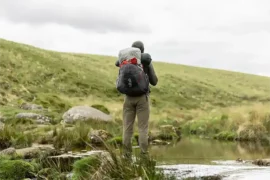In collaboration with Mammut and the British Pilgrimage Trust, take a stroll with Oliver, our guest writer as he takes on some Mammut gear and goes walking.
Writer: Oliver Smith
Photography: Beth Squire
…
The British Pilgrimage Trust has resurrected an ancient pilgrimage route through the South Downs towards Canterbury, Oliver Smith paid a visit.
The story begins, as many do, with a crinkly old map.
The ‘Gough Map’ is named after the 18th-century antiquarian Richard Gough: though he in turn inherited it from a man named Honest Tom, famous for drinking ‘strong beer for breakfast’ (and, more suspiciously, for always insisting on being called ‘Honest’). No-one in honesty knows where Tom found it, but it’s now believed the ‘Gough Map’ dates to the 14th century and has come to be regarded as the oldest road map of Great Britain. It presents a god-like view of a mediaeval land: illustrated with little turreted towns and green rivers. A ship about the size of Yorkshire sails off the page, close to a depiction of what looks like a smiling shark. At the bottom, a red line wanders over the countryside from the Solent to Canterbury.
Some six centuries later, a member of the British Pilgrimage Trust spied this line, and hypothesised it was a long-forgotten pilgrimage route – running from Southampton to the shrine of St Thomas. On a drizzly May day, I’m standing on the ‘Old Way’ – the British Pilgrimage Trust’s real-life reimagining of the red line – a 250-mile long footpath mapped not on ancient velum, but with gpx files. Dawn Champion is leading the Old Way’s 21st century revival.
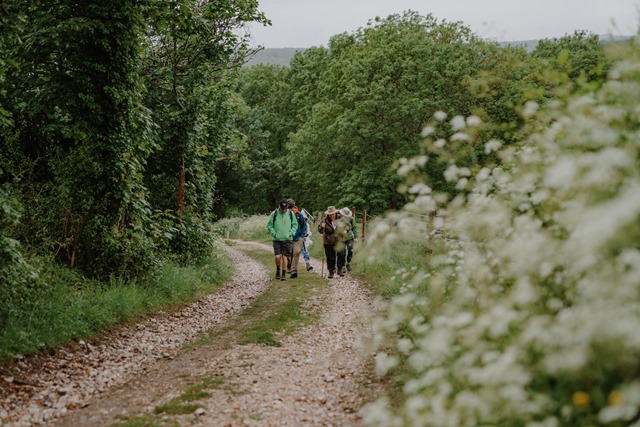
“Wherever you go in the world, almost every culture has its own version of pilgrimage,” she tells me. “Homo sapiens were once a nomadic species. You might say it is almost innate.”
I meet Dawn in a Saxon church in Stoughton, Sussex, set amidst the gentle undulations of the South Downs. It would take an ardent soul to walk the entirety of the Old Way to Canterbury – instead I’m joining her on an eight mile saunter to Chichester Cathedral. Dawn assures me that this humble effort still counts as a legitimate pilgrimage: the Old Way isn’t a place for dogma. The packing list for the day includes a packed lunch, waterproofs and “an open heart and mind.”
Nor, for that matter, is the British Pilgrimage Trust wholly affiliated to one particular religion. Founded in 2014, its aim is to promote the benefits of pilgrimage to people of all faiths (and those of none). The Old Way is its proving ground. Other pilgrims on our walk include two Roman Catholics, an atheist and someone from Wiltshire with a tattoo of holy circles on their hands (which, she hints, might represent the stones at Stonehenge or Avebury). There is also Chris: an aeronautical engineer who carries a hazel staff he fashioned in tribute to ouroboros – the ancient snake symbol representing infinity.

In the nave of the church, Dawn explains what makes a pilgrimage distinct from a walk: intention – allying your journey to a specific prayer or a hope, and charging it with a deeper meaning. Out in the graveyard she instructs us to each pick a wildflower as a token of our intention, and to carry it to journey’s end (I pocket a soggy sprig of cow parsley). Then we strike out as our mediaeval forebears might have done – trudging uphill through beechwoods and hedgerow-hemmed lanes, reaching the chalky trails that crest the spine of the South Downs. A buzzard circles overhead. Bursts of red campion dot the verges. On a clear day views from the top stretch along the coast towards Southampton – the port where pilgrims might have disembarked ships to follow the ridge to Canterbury. Today, the clouds only grudgingly part to offer a glimpse of a grey sea.

In other ways too, our potted pilgrimage is subtly different to a walk. Dawn carries a stick – useful for scaling hills, but also traditionally a means of defence against brigands on treacherous paths. She stops to teach us early English folk songs – on one hilltop we sing ‘Summer-is-A-Coming-In” into sideways rain. And she pauses to point out how mediaeval wayfarers used wild mint as an insect repellent, and clumps of Galium verum (or lady’s bedstraw, as it is also known) as a mattress for nights beside the trail.
“If you know how, you can see the landscape of the past through the lens of the present,” says Dawn. “And you learn so much by walking – when you connect places on foot you see them through different eyes.”
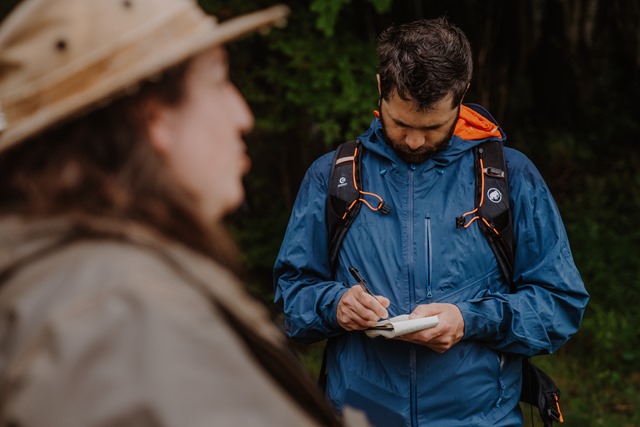
In recent times, academics have speculated that the Gough Map was revised over a period of time. In the same way, the landscape we are travelling tells a richly-layered story. In one place Iron Age earthworks are overlaid with WWII tank traps: in another Bronze Age barrows are said to be haunted by vanquished Vikings. And – though the route we are following is Christian in origins – in the margins are murmurs of the paganism that held sway here before news of Christ spread from Canterbury from the 6th century AD.

We descend into Kingley Vale – home to some of the most impressive yew woods in Europe. Today the South Downs are known for wide open spaces where the winds roam unobstructed – but once the dark, tangled realm of yews covered these contours. The surviving woods have a labyrinthine intricacy as we step inside. Some trees here are rumoured to be two millennia old – which would be old enough to remember the march of centurions and the ceremonies of druids. Their limbs wander and weave as if frozen mid-dance, their red sap has the hue of freshly drawn blood. The upper branches arch high above us – forming glades like green cathedrals.
The ancient Kingley Vale yews are, Dawn explains, still worshipped by neo-pagan groups in Sussex today: she suggests we each press our foreheads to the trees for a few minutes, feeling the wrinkles of their bark against skin. In other circumstances this might feel strange, but in the company of other pilgrims, it feels wise, natural – an act of veneration we can define on our own terms.
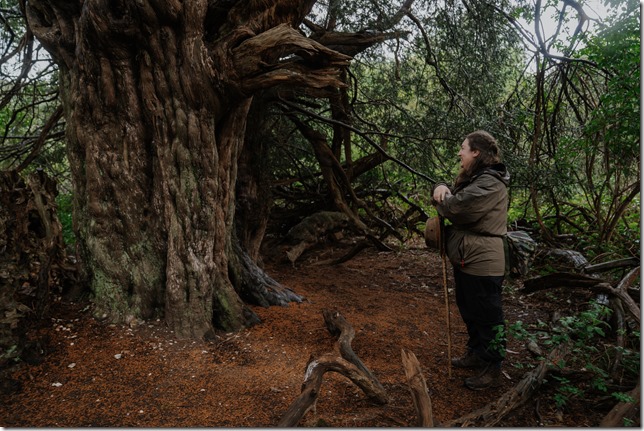
“I think today is not about so much saying I’m right and you’re wrong” says Stephen – a pilgrim and construction lawyer from Guildford. “It’s about being out here, absorbing things.”
Indeed, more people are opening their minds to the possibilities of pilgrimage – most obviously on the Camino de Santiago. Decades ago only a few hundred pilgrims trod the trail across northern Spain – these days annual traffic is as high as 350,000 hikers. Like the Camino, the Old Way hugs an upland coastline at the western edge of Europe. Like the Camino, it culminates at an ancient cathedral. But where the Spanish route has been around since the 9th century, the Old Way is a different beast. The English Reformation saw pilgrimage outlawed in the 16th century – a superstitious pastime seen through Protestant eyes. Only in modern times has the tradition been re-evaluated in England: some have picked up the trail whose meaning was forgotten five centuries before.
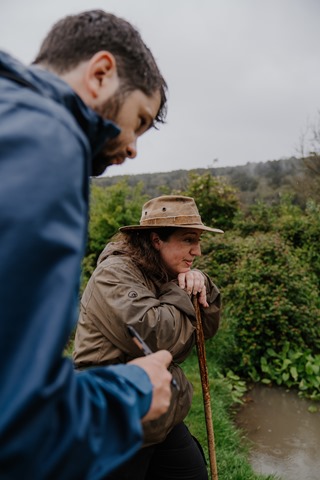
Among our party is Margaret – a Roman Catholic who became curious about pilgrimage during the claustrophobia of lockdowns. She has since walked across Northumberland to the Holy Island of Lindisfarne, and through County Kildare in the footsteps of St Brigid. Tied to her backpack is a scallop shell – the sign of the pilgrim.
“For me, the idea of pilgrimage is to turn my body into a prayer,” she says. “At the end I return home feeling healthy in body, mind and spirit.”
We stop to eat sandwiches in the porch of St Andrew’s church, West Stoke – we’re not staying long, but organising pilgrim accommodation in churches is also part of the British Pilgrimage Trust’s work. Soon, the rain eases off, spring sunlight scatters the downs – lawns glitter after rain, the song of skylarks descends from a blue sky. On the last leg the gradients flatten, and we emerge from the woods to see the spire of Chichester Cathedral rising tall over a field of barley. Dawn compares this humble Sussex field to Mount Joy – the hill on the cusp of Jerusalem where mediaeval pilgrims experienced ecstasy looking down on the walled city.
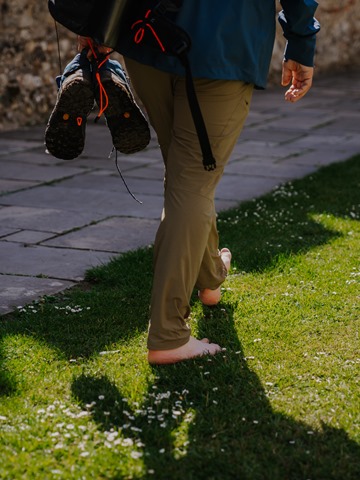
Pilgrims sometimes take off their shoes when their final destination is in sight – a recognition they had crossed a threshold to a sacred space. We keep boots on for another mile or two – crossing suburban streets – before removing them in the cloisters of the cathedral. Chichester is the only mediaeval cathedral visible from the sea – perhaps its slender spire was glimpsed by hopeful pilgrims on Southampton-bound boats. Inside, we feel the coldness of mediaeval stones underfoot – a balm for trail-weary soles – feel the crevices of carved lettering under our toes. Some pilgrims in our party pray. Others sit and think. One or two crane their necks to see slanting sunlight illuminate stained glass. We stay for evensong: listening to the cadences of the choir echoing in the heights.
A pilgrimage has the same symmetry of a human life: a starting point and a destination: obstacles to overcome on the way, baggage to carry – and human company that makes the load seem lighter. Though our endpoint is a Christian cathedral, Dawn has also welcomed Buddhists, Muslims, neopagans and atheists on her walks. She says everyone always gets along with each other.
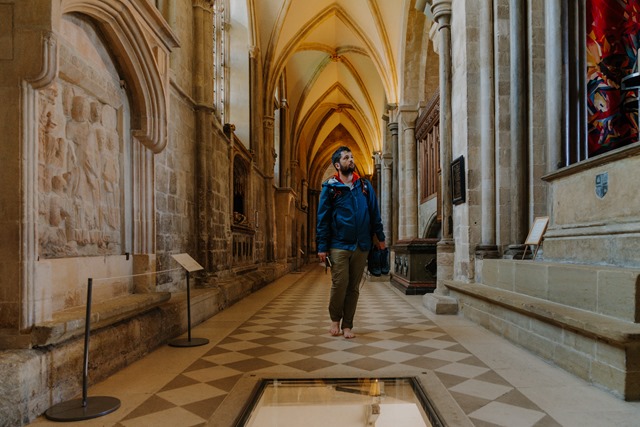
“When you’re facing someone across a table, it can be confrontational. But on a pilgrimage, everyone is facing in the same direction. We’re all walking side by side.”
…
Shop our range of Mammut gear online HERE
or
Learn more about the British Pilgrimage Trust








